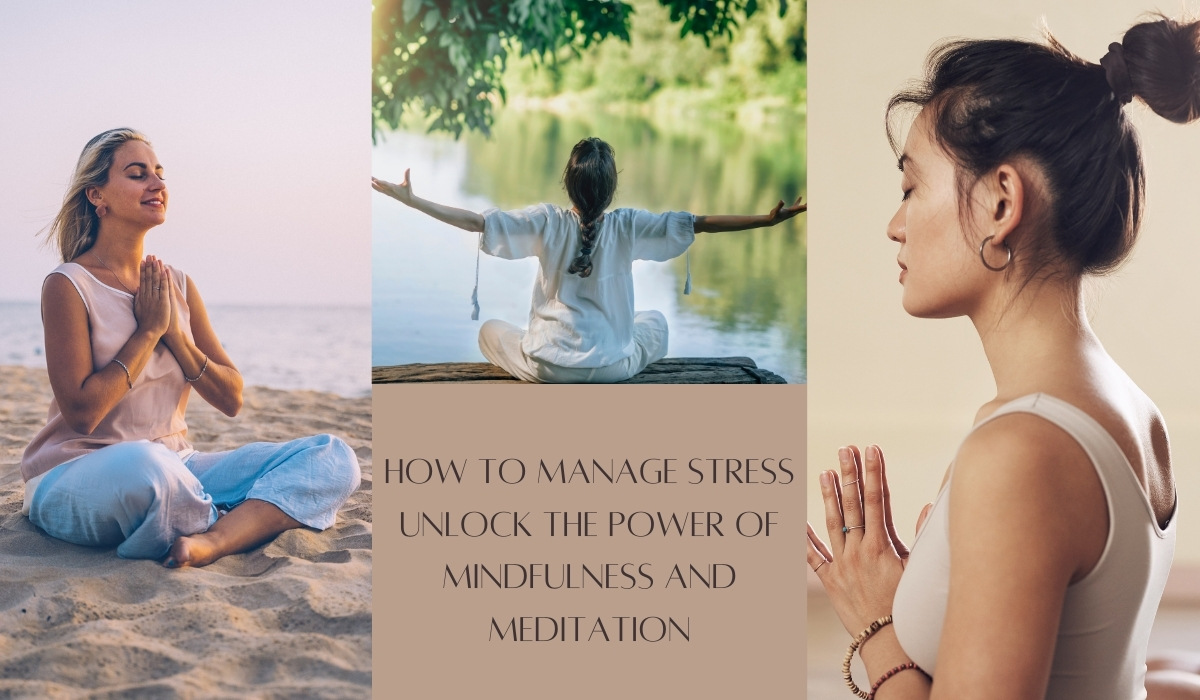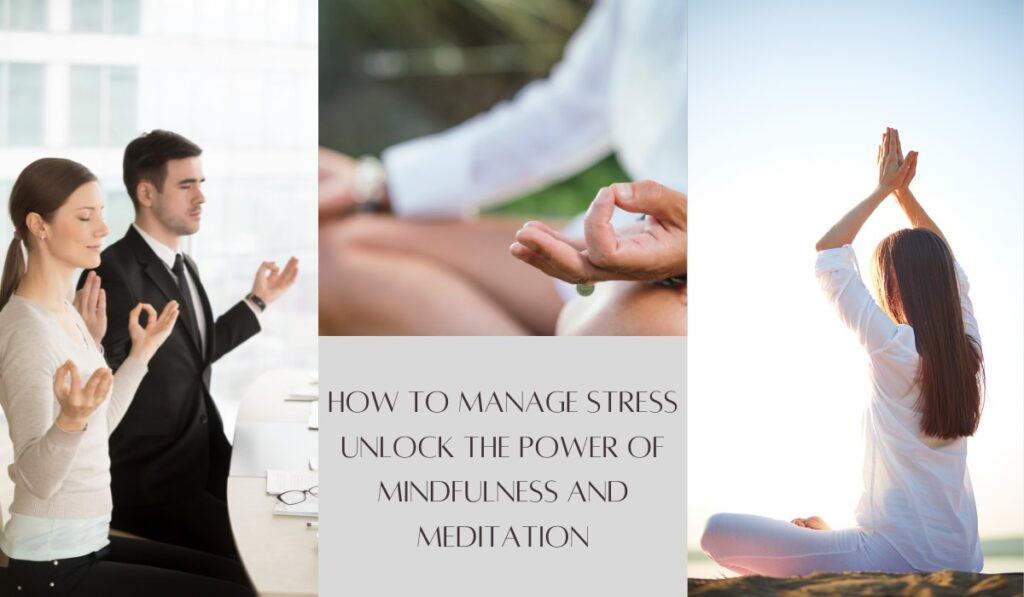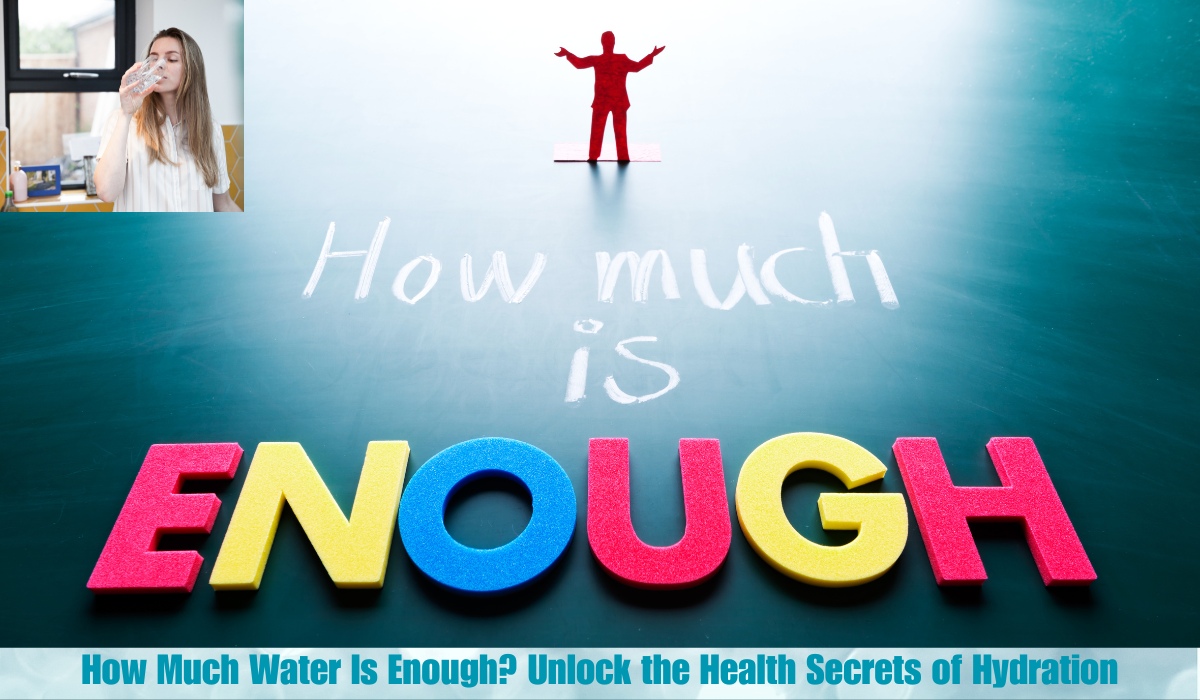How to Manage Stress – Unlock the Power of Mindfulness and Meditation

Description
Discover how mindfulness meditation can be your ultimate tool for stress reduction. Explore scientifically backed techniques that are easy to implement and learn how to transform your mind to combat everyday stress effectively. Whether new to meditation or a seasoned practitioner, this guide offers actionable insights to help you lead a calmer, more focused life.
Introduction
In the present fast world, stress has become a typical day-to-day existence. Whether it’s due to demanding jobs, personal responsibilities, or the constant influx of information, stress can significantly impact both our physical and mental well-being. Mindfulness meditation offers a natural, scientifically-supported method to reduce stress and enhance overall health. This guide delves into the science behind mindfulness meditation, highlights the pervasive nature of stress, explores the consequences of unmanaged stress, and presents practical, evidence-based meditation techniques to help you manage stress effectively.

How to Manage Stress – Unlock the Power of Mindfulness and Meditation!
Problem: The Prevalence and Impact of Stress
The Modern Stress Landscape
Stress is a widespread issue affecting individuals across all demographics. According to the American Psychological Association (APA), 75% of adults report experiencing moderate to high levels of stress in the past month.
The primary sources of this stress include:
- Work-related pressures: 65%
- Financial concerns: 64%
- Personal responsibilities: 60%
- Health issues: 50%
- Relationship problems: 45%
Table 1: Common Sources of Stress Among Adults.
| Source of Stress | Percentage of Adults Affected |
| Work-related pressures | 65% |
| Financial concerns | 64% |
| Personal responsibilities | 60% |
| Health concerns | 50% |
| Relationships | 45% |
Health Consequences of Chronic Stress
Chronic stress can lead to a range of health problems, both mental and physical:
- Mental Health Issues: Anxiety, depression, and burnout are common results of prolonged stress.
- Physical Health Problems: High blood pressure, heart disease, digestive issues, and a weakened immune system are associated with chronic stress.
- Cognitive Impairments: Stress can hinder concentration, memory, and decision-making abilities.
A study published in the Journal of Health Psychology found that chronic stress can elevate the risk of developing major depressive disorder by 30%.
Economic and Social Impact
Beyond individual health, stress has significant economic and social repercussions. The APA estimates that stress-related absenteeism costs employers around $300 billion annually in the United States alone. Additionally, stress can strain personal relationships and diminish overall life satisfaction, creating a ripple effect that impacts communities and society at large.
The Domino Effect of Unmanaged Stress
Mental and Emotional Toll
Unmanaged stress doesn’t just cause immediate discomfort—it has long-lasting effects on mental and emotional health. Persistent stress can lead to:
- Depression and Anxiety: Continuous exposure to stress hormones like cortisol can alter brain chemistry, increasing the risk of mood disorders.
- Emotional Exhaustion: Feeling drained and unable to manage daily demands.
Physical Health Deterioration
The physical implications of chronic stress are extensive:
- Cardiovascular Issues: Elevated heart rate and blood pressure can contribute to heart disease.
- Gastrointestinal Problems: Stress can worsen conditions like irritable bowel syndrome (IBS) and acid reflux.
- Immune Suppression: Chronic stress weakens the immune system, making the body more vulnerable to infections.
Reduced Productivity and Quality of Life
Stress adversely impacts productivity and quality of life. It can result in diminished work performance, increased errors, and higher workplace turnover rates. On a personal level, stress can strain relationships and lower overall life satisfaction.
Case Study: Workplace Stress and Employee Wellness
A study conducted at a major financial firm revealed that employees experiencing high-stress levels reported a 20% decline in productivity and a 15% rise in absenteeism. Implementing stress reduction programs, including mindfulness meditation, led to a 30% decrease in reported stress levels and a 25% enhancement in productivity within six months.
Solution: Mindfulness Meditation Techniques for Reducing Stress
Mindfulness meditation is a scientifically supported method for managing and alleviating stress. Below, we explore various mindfulness techniques that can be incorporated into daily life to combat stress effectively.
1. Breath Awareness Meditation
What It Is: Breath awareness meditation centers on the natural rhythm of breathing, observing each inhale and exhale without attempting to alter it.
How It Reduces Stress: This technique anchors the mind in the present moment, diminishing rumination and anxiety. By concentrating on the breath, individuals can disrupt the stress response and activate the relaxation response.
Factual Data: A study published in JAMA Internal Medicine found that participants practicing breath awareness meditation for eight weeks experienced a significant reduction in stress levels compared to a control group.
How to Practice:
- Find a quiet place to sit comfortably.
- Close your eyes and take a few deep breaths to relax.
- Focus your attention on your breath, noticing the sensation of air entering and leaving your nostrils.
- If your mind wanders, gently redirect your focus back to your breath.
2. Body Scan Meditation
What It Is: Body scan meditation involves sequentially focusing on various parts of the body, from head to toe, to identify and release tension.
How It Reduces Stress: This technique enhances body awareness and promotes relaxation by systematically releasing physical tension that builds up due to stress.
Factual Data: Research in Psychosomatic Medicine indicated that body scan meditation significantly reduced perceived stress and physical symptoms of tension.
How to Practice:
- Lie down in a comfortable position.
- Close your eyes and take a few deep breaths.
- Start at the top of your head and slowly move your attention down to your toes, noticing any areas of tension.
- Breathe into each tense area, imagining the tension dissolving as you exhale.
3. Loving-Kindness Meditation (Metta)
What It Is: Loving-kindness meditation involves directing feelings of love and compassion towards oneself and others.
How It Reduces Stress: By fostering positive emotions and reducing negative self-talk, this technique can decrease stress and enhance emotional resilience.
Factual Data: A study published in Emotion showed that participants practicing loving-kindness meditation experienced increased positive emotions and reduced levels of the stress hormone cortisol.
How to Practice: Sit comfortably and close your eyes.
Focus on your heart and silently repeat phrases like “May I be happy, may I be healthy, may I be safe.”
Gradually extend these wishes to others, including friends, family, and even those you find challenging.

4. Mindful Walking
What It Is: Mindful walking entails walking slowly while closely observing the physical sensations of walking, such as the movement of your feet and the rhythm of your steps.
How It Reduces Stress: This technique merges the advantages of physical exercise with mindfulness, fostering both mental and physical relaxation.
Factual Data: A study published in Frontiers in Psychology revealed that mindful walking can diminish perceived stress and enhance mood more effectively than regular walking.
How to Practice:
- Choose a quiet location to walk without distractions.
- Walk slowly, focusing on each step and the sensations in your feet.
- Observe the movement of your legs and the shifting of your weight.
- If your mind drifts, gently redirect your attention back to the act of walking.
5. Guided Imagery
What It Is: Guided imagery involves visualizing calming and serene images to encourage relaxation and alleviate stress.
How It Reduces Stress: Engaging the imagination in positive scenarios can divert focus from stressors, nurturing a sense of calm and well-being.
Factual Data: According to a study in the Journal of Behavioral Medicine, guided imagery significantly lowered stress levels and improved overall mood in participants.
How to Practice:
- Find a quiet spot to sit or lie down.
- Close your eyes and take several deep breaths.
- Envision a tranquil scene, such as a beach or a forest.
- Engage all your senses in the visualization, noticing sounds, scents, and physical sensations.
6. Mindful Eating
What It Is: Mindful eating involves fully concentrating on the experience of eating, savoring each bite, and being aware of hunger and fullness signals.
How It Reduces Stress: Mindful eating can turn mealtime into a calming activity, alleviating the stress linked to hurried or mindless eating.
Factual Data: A study in Appetite found that mindful eating practices were associated with lower cortisol levels and reduced stress-related eating behaviors.
How to Practice:
- Choose a meal or snack to enjoy mindfully.
- Take a few deep breaths before you start eating.
- Eat slowly, giving full attention to each bite.
- Notice the flavors, textures, and sensations of the food.
- Stop eating when you feel satisfied, not when you are full.
7. Mindful Journaling
What It Is: Mindful journaling involves writing down your thoughts, feelings, and experiences in a non-judgmental manner.
How It Reduces Stress: Writing can help process emotions and identify stressors, providing clarity and alleviating mental burdens.
Factual Data: Research published in Psychological Science found that expressive writing reduced stress and improved mental health among participants.
How to Practice:
- Set aside a few minutes each day to journal.
- Write down whatever comes to mind without self-censorship.
- Focus on expressing your thoughts and feelings honestly and without judgment.
- After writing, take a few deep breaths and notice how you feel.
8. Progressive Muscle Relaxation (PMR)
What It Is: PMR involves tensing and then relaxing each muscle group in the body, systematically working through the entire body.
How It Reduces Stress: This technique helps release physical tension, which can lower overall stress levels and promote relaxation.
Factual Data: A study in the American Journal of Medicine found that progressive muscle relaxation effectively reduced stress and anxiety in participants.
How to Practice:
- Find a quiet place to sit or lie down.
- Starting with your toes, tense each muscle group for a few seconds, then relax.
- Move up through your body, tensing and relaxing each muscle group.
- Notice the difference between tension and relaxation.
9. Mindful Breathing
What It Is: Mindful breathing is a technique where you focus on the rhythm of your breath, observing each inhale and exhale.
How It Reduces Stress: Focusing on the breath helps calm the nervous system and mitigate the physiological effects of stress.
Factual Data: A study published in Frontiers in Human Neuroscience demonstrated that mindful breathing practices lower cortisol levels and enhance emotional regulation.
How to Practice:
- Sit or lie down in a comfortable position.
- Close your eyes and focus on your breath.
- Notice the sensation of air entering and leaving your lungs.
- If your mind wanders, gently redirect your focus back to your breath.
10. Mindful Listening
What It Is: Mindful listening involves fully attending to the sounds around you, without judgment or distraction.
How It Reduces Stress: By enhancing your awareness of the present moment, mindful listening can diminish the mental chatter that contributes to stress.
Factual Data: A study in the Journal of Environmental Psychology found that mindful listening practices increased relaxation and decreased stress levels among participants.
How to Practice:
- Find a quiet place to sit or stand.
- Close your eyes and focus on the sounds around you.
- Notice the different tones, pitches, and rhythms of the sounds.
- If your brain meanders, tenderly take your consideration back to the sounds.
Table 2: Impact of Mindfulness Meditation Techniques on Stress Levels
| Technique | Primary Benefit | Study/Case Study Reference |
| Breath Awareness Meditation | Reduces anxiety and stress | JAMA Internal Medicine – 8-week breath awareness study |
| Body Scan Meditation | Releases physical tension | Psychosomatic Medicine – reduced perceived stress |
| Loving-Kindness Meditation | Increases positive emotions | Emotion – increased positive emotions, decreased cortisol |
| Mindful Walking | Combines physical exercise with relaxation | Frontiers in Psychology – improved mood and reduced stress |
| Guided Imagery | Promotes relaxation through visualization | Journal of Behavioral Medicine – reduced stress, improved mood |
| Mindful Eating | Transforms mealtime into relaxation | Appetite – lower cortisol, reduced stress-related eating behaviors |
| Mindful Journaling | Processes emotions, reduces mental burden | Psychological Science – reduced stress, improved mental health |
| Progressive Muscle Relaxation | Releases physical tension | American Journal of Medicine – reduced stress and anxiety |
| Mindful Breathing | Calms nervous system, reduces physiological stress | Frontiers in Human Neuroscience – lower cortisol, better emotional regulation |
| Mindful Listening | Enhances present moment awareness, reduces mental chatter | Journal of Environmental Psychology – increased relaxation, decreased stress |

Implementing Mindfulness Meditation in Daily Life
Starting Small
Integrating care reflection into your routine doesn’t demand a huge time responsibility. Start with only five minutes per day and progressively increment the term as you become more alright with the training.
Consistency is Key
Customary practice is fundamental for encountering the full advantages of care reflection. Mean to rehearse simultaneously every day to lay out a propensity.
Finding the Right Technique
Different techniques work better for different individuals. Experiment with various methods to discover the one that best suits your lifestyle and stress management needs.
Creating a Suitable Environment
Select a quiet, comfortable space free from distractions to practice mindfulness meditation. This can improve the adequacy of your training.
Combining Techniques
You don’t need to adhere to a single technique. Merging different mindfulness practices can offer a more comprehensive approach to stress reduction.
Case Studies: Real-World Success with Mindfulness Meditation
Case Study 1: Reducing Workplace Stress
A large tech company launched a mindfulness meditation program, encouraging employees to engage in mindfulness for 10 minutes each day. After eight weeks, employees reported a 28% reduction in stress levels. Furthermore, there was a notable improvement in focus, creativity, and overall job satisfaction.
Details:
- Participants: 200 employees
- Duration: 8 weeks
- Outcome: 28% reduction in stress, improved focus and creativity, increased job satisfaction.
Case Study 2: Managing Anxiety and Depression
A 2019 study published in JAMA Internal Medicine investigated the effects of mindfulness meditation on individuals with anxiety and depression. Participants practiced mindfulness for 12 weeks and demonstrated significant improvements in anxiety and depressive symptoms compared to the control group.
Details:
- Participants: 1,000 adults with anxiety and depression
- Duration: 12 weeks
- Outcome: Significant reduction in anxiety and depressive symptoms.
Case Study 3: Enhancing Athletic Performance through Mindfulness
A study involving collegiate athletes revealed that those who engaged in mindfulness meditation experienced reduced stress levels and enhanced performance in their respective sports. The athletes noted improved focus during competitions and a decrease in pre-game anxiety.
Details:
- Participants: 50 collegiate athletes
- Duration: 6 weeks
- Outcome: Reduced stress levels, enhanced performance, improved focus, decreased anxiety.
Case Study 4: Mindfulness in Schools
A school district implemented mindfulness meditation programs for students to assist in managing academic stress. After one semester, students reported improved stress management, heightened concentration in class, and better academic performance.
Details:
- Participants: 500 middle and high school students
- Duration: 4 months
- Outcome: Improved stress management, heightened concentration, and better academic performance.
Practical Tips for Effective Mindfulness Meditation
Setting Realistic Goals
Establish achievable goals for your meditation practice to sustain motivation. Begin with short sessions and gradually extend them as you grow more comfortable.
Using Technology
Leverage mindfulness apps and online resources to enhance your meditation practice. Apps like Headspace and Calm provide guided sessions tailored to various needs.
Joining a community
Engaging in group meditation sessions or becoming part of a mindfulness community can offer support and enrich your practice.
Tracking Progress
Maintain a journal to monitor your meditation practice and observe changes in your stress levels over time. This can help you remain committed and recognize the benefits.
Addressing Common Challenges in Mindfulness Meditation
Dealing with a Wandering Mind
It is normal for the brain to meander during contemplation. Acknowledge distractions without judgment and gently redirect your focus back to your chosen point of concentration, such as your breath.
Finding Time
Incorporate mindfulness meditation into your daily routine by practicing during breaks, before bed, or upon waking. Even brief sessions can be effective.
Staying Consistent
Ensure consistency by setting reminders, creating a dedicated meditation space, and making it a non-negotiable part of your day.
Overcoming Skepticism
If you’re doubtful about the benefits of mindfulness meditation, start with guided sessions or short practices to experience immediate relaxation and gradually build trust in the practice.

Conclusion
Embrace Mindfulness Meditation for a Stress-Free Life
Stress is an unavoidable aspect of life, but how we handle it can significantly impact our overall health. Mindfulness meditation provides a scientifically validated, natural method to alleviate stress and enhance both mental and physical well-being. By integrating techniques such as breath awareness, body scan, loving-kindness, and mindful walking into your daily routine, you can effectively manage stress and improve your quality of life.
Begin with small steps, maintain consistency, and practice patience with yourself as you cultivate your mindfulness practice. The advantages go beyond mere stress reduction, fostering better emotional regulation, heightened focus, and a deeper sense of peace and wellness. Incorporate mindfulness meditation into your life today and take a proactive step towards a healthier, more balanced future.
References
- American Psychological Association. (2023). Stress in America: Coping with Change.
- Kabat-Zinn, J. (2003). Mindfulness-based interventions in context: Past, present, and future. Clinical Psychology: Science and Practice, 10(2), 144-156.
- Chiesa, A., & Serretti, A. (2009). Mindfulness-based stress reduction for stress management in healthy people: A review and meta-analysis. Journal of Alternative and Complementary Medicine, 15(5), 593-600.
- Link
- Goyal, M., et al. (2014). Meditation programs for psychological stress and wellness: A systematic review and meta-analysis. JAMA Internal Medicine, 174(3), 357-368.
- Link
- Hölzel, B. K., et al. (2011). Mindfulness practice leads to increases in regional brain gray matter density. Psychiatry Research: Neuroimaging, 191(1), 36-43.
- JAMA Internal Medicine. (2019). Mindfulness meditation for anxiety and depression.
- Link
- Psychosomatic Medicine. (2015). Body scan meditation and stress reduction.
- Link
- Emotion. (2010). Loving-kindness meditation increases positive emotions and reduces cortisol levels.
- Frontiers in Psychology. (2018). Effects of mindful walking on stress and mood.
- Link
- Appetite. (2016). Mindful eating practices and cortisol levels.
- Psychological Science. (2013). Expressive writing and stress reduction.
- Link
- American Journal of Medicine. (2017). Progressive muscle relaxation for stress and anxiety.
- Link
- Journal of Environmental Psychology. (2016). Mindful listening and stress reduction.
- Journal of Behavioral Medicine. (2007). Guided imagery and stress reduction.
- Frontiers in Human Neuroscience. (2017). Mindful breathing lowers cortisol.


